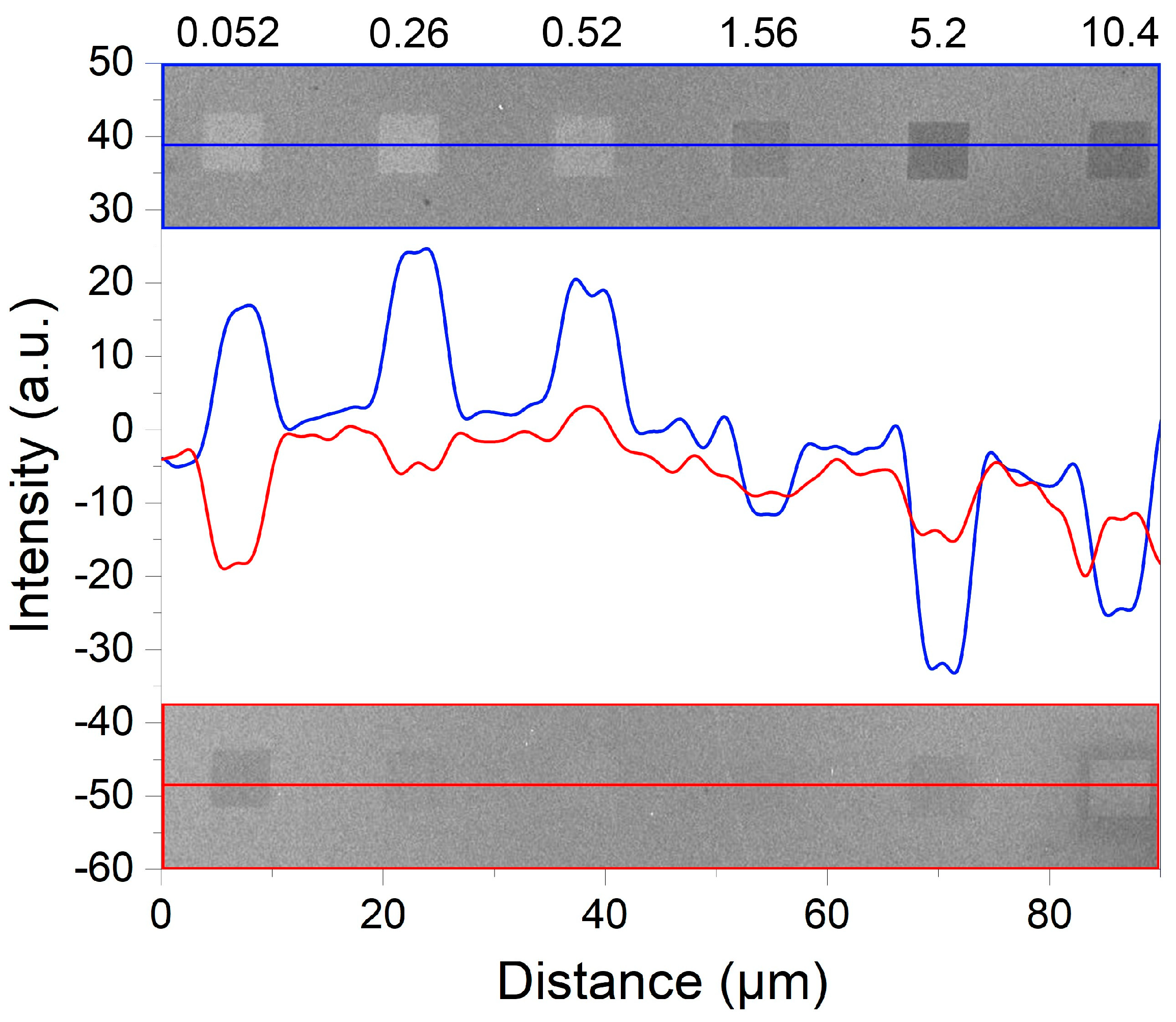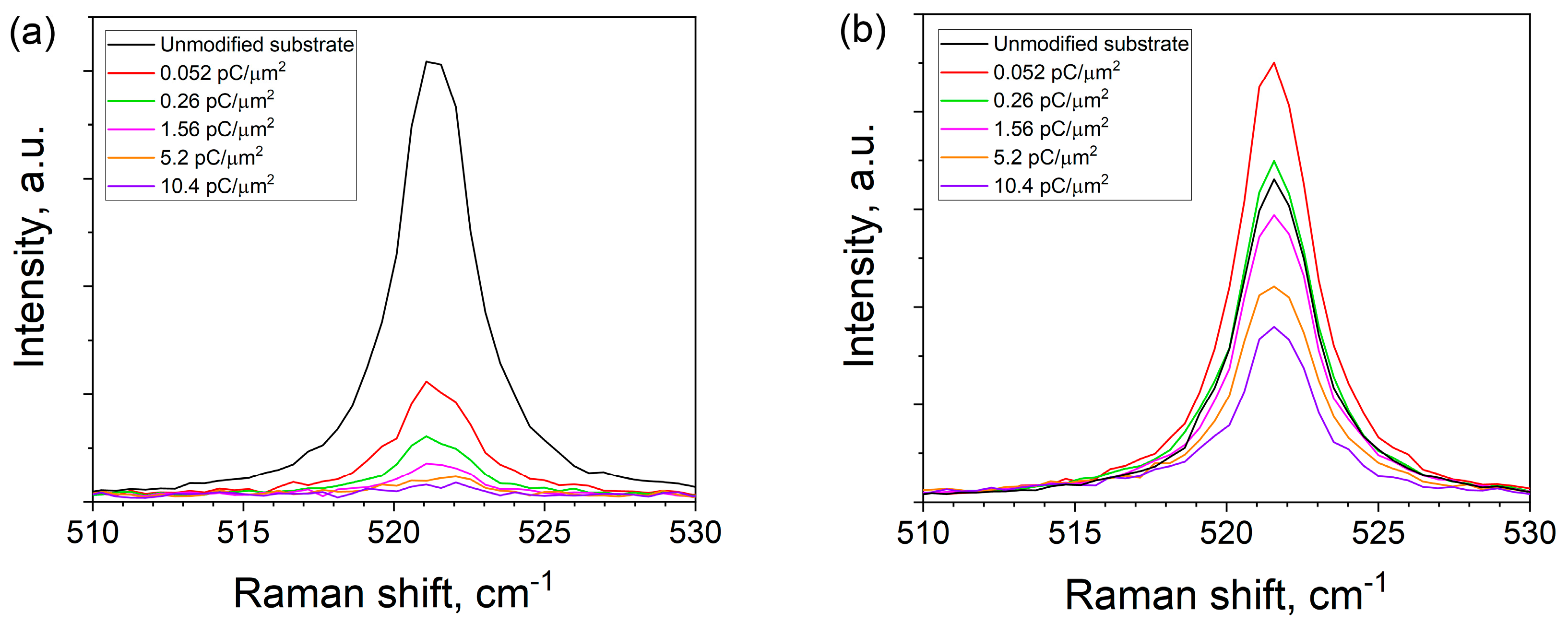Effect of Si(111) Surface Modification by Ga Focused Ion Beam at 30 kV on GaAs Nanowire Growth
Abstract
:1. Introduction
2. Results and Discussion
2.1. GaAs Nanowire Growth within FIB-Modified Areas
2.2. FIB Modification Effect on Si(111) Surface
2.3. Proposed Mechanisms of GaAs NW Growth within FIB-Modified Areas
2.3.1. Area I (Ion Dose Is from Below 0.052 pC/µm2 to ~0.1 pC/µm2)
2.3.2. Area II (Ion Dose Is from ~0.1 pC/µm2 to ~1.0 pC/µm2)
2.3.3. Area III (Ion Dose Is from ~1.0 pC/µm2 and Above)
3. Materials and Methods
3.1. Sample Preparation
3.2. Sample Characterization
4. Conclusions
Supplementary Materials
Author Contributions
Funding
Institutional Review Board Statement
Informed Consent Statement
Data Availability Statement
Conflicts of Interest
References
- Balaghi, L.; Shan, S.; Fotev, I.; Moebus, F.; Rana, R.; Venanzi, T.; Hübner, R.; Mikolajick, T.; Schneider, H.; Helm, M.; et al. High Electron Mobility in Strained GaAs Nanowires. Nat. Commun. 2021, 12, 6642. [Google Scholar] [CrossRef] [PubMed]
- Das, A.; Heo, J.; Jankowski, M.; Guo, W.; Zhang, L.; Deng, H.; Bhattacharya, P. Room Temperature Ultralow Threshold GaN Nanowire Polariton Laser. Phys. Rev. Lett. 2011, 107, 066405. [Google Scholar] [CrossRef] [PubMed] [Green Version]
- Shen, L.; Pun, E.Y.B.; Ho, J.C. Recent Developments in III–V Semiconducting Nanowires for High-Performance Photodetectors. Mater. Chem. Front. 2017, 1, 630–645. [Google Scholar] [CrossRef]
- Garnett, E.C.; Brongersma, M.L.; Cui, Y.; McGehee, M.D. Nanowire Solar Cells. Annu. Rev. Mater. Res. 2011, 41, 269–295. [Google Scholar] [CrossRef] [Green Version]
- Barrigón, E.; Heurlin, M.; Bi, Z.; Monemar, B.; Samuelson, L. Synthesis and Applications of III–V Nanowires. Chem. Rev. 2019, 119, 9170–9220. [Google Scholar] [CrossRef] [PubMed]
- Zhang, Y.; Wu, J.; Aagesen, M.; Liu, H. III–V Nanowires and Nanowire Optoelectronic Devices. J. Phys. D Appl. Phys. 2015, 48, 463001. [Google Scholar] [CrossRef]
- Plissard, S.; Larrieu, G.; Wallart, X.; Caroff, P. High Yield of Self-Catalyzed GaAs Nanowire Arrays Grown on Silicon via Gallium Droplet Positioning. Nanotechnology 2011, 22, 275602. [Google Scholar] [CrossRef]
- Dubrovskii, V.G.; Xu, T.; Álvarez, A.D.; Plissard, S.R.; Caroff, P.; Glas, F.; Grandidier, B. Self-Equilibration of the Diameter of Ga-Catalyzed GaAs Nanowires. Nano Lett. 2015, 15, 5580–5584. [Google Scholar] [CrossRef]
- Seo, K.; Wober, M.; Steinvurzel, P.; Schonbrun, E.; Dan, Y.; Ellenbogen, T.; Crozier, K.B. Multicolored Vertical Silicon Nanowires. Nano Lett. 2011, 11, 1851–1856. [Google Scholar] [CrossRef]
- Munshi, A.M.; Dheeraj, D.L.; Fauske, V.T.; Kim, D.C.; Huh, J.; Reinertsen, J.F.; Ahtapodov, L.; Lee, K.D.; Heidari, B.; van Helvoort, A.T.J.; et al. Position-Controlled Uniform GaAs Nanowires on Silicon Using Nanoimprint Lithography. Nano Lett. 2014, 14, 960–966. [Google Scholar] [CrossRef]
- Küpers, H.; Tahraoui, A.; Lewis, R.B.; Rauwerdink, S.; Matalla, M.; Krüger, O.; Bastiman, F.; Riechert, H.; Geelhaar, L. Surface Preparation and Patterning by Nano Imprint Lithography for the Selective Area Growth of GaAs Nanowires on Si(111). Semicond. Sci. Technol. 2017, 32, 115003. [Google Scholar] [CrossRef] [Green Version]
- Fuhrmann, B.; Leipner, H.S.; Höche, H.-R.; Schubert, L.; Werner, P.; Gösele, U. Ordered Arrays of Silicon Nanowires Produced by Nanosphere Lithography and Molecular Beam Epitaxy. Nano Lett. 2005, 5, 2524–2527. [Google Scholar] [CrossRef] [PubMed]
- Madaria, A.R.; Yao, M.; Chi, C.; Huang, N.; Lin, C.; Li, R.; Povinelli, M.L.; Dapkus, P.D.; Zhou, C. Toward Optimized Light Utilization in Nanowire Arrays Using Scalable Nanosphere Lithography and Selected Area Growth. Nano Lett. 2012, 12, 2839–2845. [Google Scholar] [CrossRef] [PubMed]
- McIntyre, P.C.; Fontcuberta i Morral, A. Semiconductor Nanowires: To Grow or Not to Grow? Mater. Today Nano 2020, 9, 100058. [Google Scholar] [CrossRef]
- Lilley, C.M.; Huang, Q. Surface Contamination Effects on Resistance of Gold Nanowires. Appl. Phys. Lett. 2006, 89, 203114. [Google Scholar] [CrossRef]
- Fan, H.J.; Werner, P.; Zacharias, M. Semiconductor Nanowires: From Self-Organization to Patterned Growth. Small 2006, 2, 700–717. [Google Scholar] [CrossRef]
- Detz, H.; Kriz, M.; Lancaster, S.; MacFarland, D.; Schinnerl, M.; Zederbauer, T.; Andrews, A.M.; Schrenk, W.; Strasser, G. Lithography-Free Positioned GaAs Nanowire Growth with Focused Ion Beam Implantation of Ga. J. Vac. Sci. Technol. B 2017, 35, 011803. [Google Scholar] [CrossRef] [Green Version]
- Bahrami, D.; Mostafavi Kashani, S.M.; Al Hassan, A.; Davtyan, A.; Pietsch, U. High Yield of Self-Catalyzed GaAs Nanowire Growth on Silicon(111) Substrate Templated by Focused Ion Beam Patterning. Nanotechnology 2020, 31, 185302. [Google Scholar] [CrossRef]
- Lancaster, S.; Kriz, M.; Schinnerl, M.; MacFarland, D.; Zederbauer, T.; Andrews, A.M.; Schrenk, W.; Strasser, G.; Detz, H. Focused Ion Beam Implantation for the Nucleation of Self-Catalyzed III-V Nanowires. Microelectron. Eng. 2017, 177, 93–97. [Google Scholar] [CrossRef]
- Mosberg, A.B.; Myklebost, S.; Ren, D.; Weman, H.; Fimland, B.O.; van Helvoort, A.T.J. Evaluating Focused Ion Beam Patterning for Position-Controlled Nanowire Growth Using Computer Vision. J. Phys. Conf. Ser. 2017, 902, 012020. [Google Scholar] [CrossRef]
- Gierak, J.; Madouri, A.; Bourhis, E.; Travers, L.; Lucot, D.; Harmand, J.C. Focused Gold Ions Beam for Localized Epitaxy of Semiconductor Nanowires. Microelectron. Eng. 2010, 87, 1386–1390. [Google Scholar] [CrossRef]
- Scholz, S.; Schott, R.; Labud, P.A.; Somsen, C.; Reuter, D.; Ludwig, A.; Wieck, A.D. Focused Ion Beam Supported Growth of Monocrystalline Wurtzite InAs Nanowires Grown by Molecular Beam Epitaxy. J. Cryst. Growth 2017, 470, 46–50. [Google Scholar] [CrossRef]
- Bussone, G.; Schott, R.; Biermanns, A.; Davydok, A.; Reuter, D.; Carbone, G.; Schülli, T.U.; Wieck, A.D.; Pietsch, U. Grazing-Incidence X-Ray Diffraction of Single GaAs Nanowires at Locations Defined by Focused Ion Beams. J. Appl. Crystallogr. 2013, 46, 887–892. [Google Scholar] [CrossRef] [PubMed] [Green Version]
- Hetzel, M.; Lugstein, A.; Zeiner, C.; Wójcik, T.; Pongratz, P.; Bertagnolli, E. Ultra-Fast Vapour–Liquid–Solid Synthesis of Si Nanowires Using Ion-Beam Implanted Gallium as Catalyst. Nanotechnology 2011, 22, 395601. [Google Scholar] [CrossRef] [PubMed]
- Bassim, N.; Scott, K.; Giannuzzi, L.A. Recent Advances in Focused Ion Beam Technology and Applications. MRS Bull. 2014, 39, 317–325. [Google Scholar] [CrossRef] [Green Version]
- Leamy, H.J. Charge Collection Scanning Electron Microscopy. J. Appl. Phys. 1982, 53, R51–R80. [Google Scholar] [CrossRef]
- Korolev, D.S.; Matyunina, K.S.; Nikolskaya, A.A.; Kriukov, R.N.; Nezhdanov, A.V.; Belov, A.I.; Mikhaylov, A.N.; Sushkov, A.A.; Pavlov, D.A.; Yunin, P.A.; et al. Ion-Beam Synthesis of Gallium Oxide Nanocrystals in a SiO2/Si Dielectric Matrix. Nanomaterials 2022, 12, 1840. [Google Scholar] [CrossRef]
- Matteini, F.; Tütüncüoglu, G.; Mikulik, D.; Vukajlovic-Plestina, J.; Potts, H.; Leran, J.-B.; Carter, W.C.; Fontcuberta i Morral, A. Impact of the Ga Droplet Wetting, Morphology, and Pinholes on the Orientation of GaAs Nanowires. Cryst. Growth Des. 2016, 16, 5781–5786. [Google Scholar] [CrossRef] [Green Version]
- Detz, H.; Kriz, M.; MacFarland, D.; Lancaster, S.; Zederbauer, T.; Capriotti, M.; Andrews, A.M.; Schrenk, W.; Strasser, G. Nucleation of Ga Droplets on Si and SiOx Surfaces. Nanotechnology 2015, 26, 315601. [Google Scholar] [CrossRef]
- Bábor, P.; Duda, R.; Polčák, J.; Průša, S.; Potoček, M.; Varga, P.; Čechal, J.; Šikola, T. Real-Time Observation of Self-Limiting SiO2/Si Decomposition Catalysed by Gold Silicide Droplets. RSC Adv. 2015, 5, 101726–101731. [Google Scholar] [CrossRef]





Disclaimer/Publisher’s Note: The statements, opinions and data contained in all publications are solely those of the individual author(s) and contributor(s) and not of MDPI and/or the editor(s). MDPI and/or the editor(s) disclaim responsibility for any injury to people or property resulting from any ideas, methods, instructions or products referred to in the content. |
© 2022 by the authors. Licensee MDPI, Basel, Switzerland. This article is an open access article distributed under the terms and conditions of the Creative Commons Attribution (CC BY) license (https://creativecommons.org/licenses/by/4.0/).
Share and Cite
Shandyba, N.; Balakirev, S.; Sharov, V.; Chernenko, N.; Kirichenko, D.; Solodovnik, M. Effect of Si(111) Surface Modification by Ga Focused Ion Beam at 30 kV on GaAs Nanowire Growth. Int. J. Mol. Sci. 2023, 24, 224. https://doi.org/10.3390/ijms24010224
Shandyba N, Balakirev S, Sharov V, Chernenko N, Kirichenko D, Solodovnik M. Effect of Si(111) Surface Modification by Ga Focused Ion Beam at 30 kV on GaAs Nanowire Growth. International Journal of Molecular Sciences. 2023; 24(1):224. https://doi.org/10.3390/ijms24010224
Chicago/Turabian StyleShandyba, Nikita, Sergey Balakirev, Vladislav Sharov, Natalia Chernenko, Danil Kirichenko, and Maxim Solodovnik. 2023. "Effect of Si(111) Surface Modification by Ga Focused Ion Beam at 30 kV on GaAs Nanowire Growth" International Journal of Molecular Sciences 24, no. 1: 224. https://doi.org/10.3390/ijms24010224





